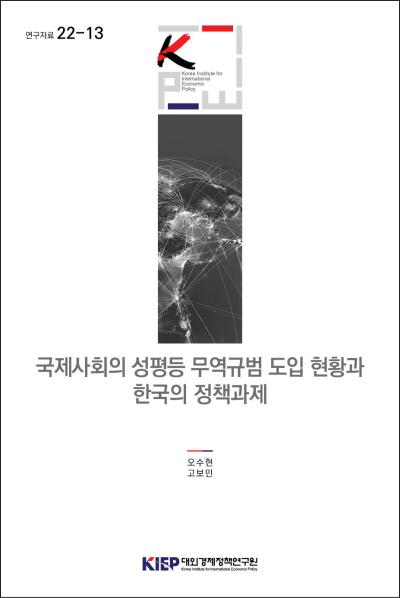Policy Analyses
Publications
Policy Analyses
To list

Introduction of the ‘Trade and Gender’ Rules and its Policy Implications
economic growth, trade policy
Author Soo Hyun (Catherine) Oh and Bomin Ko Series 22-13 Language Korean Date 2023.05.06
This study examines the latest standard linking trade and gender and suggests policy implications as Korea prepares to introduce the first gender chapter in an FTA.
Inclusive growth or sustainable growth approach, an alternative to the growing inequalities that have emerged during globalization and trade expansion, is also applicable to trade and women. The discussion on trade and gender is based on the idea that the impact of trade may differ by gender. Factors that prevent women from reaping the benefits of trade include the existence of unique barriers to trade for women; the low level of direct participation in trade by the service sector, where women predominantly work; and the generally small size of firms worked in or owned by women. Therefore, there is a need to elaborate trade policies to provide opportunities for women to participate in trade and to ensure that women share in the benefits of trade, which will lead to quantitative and qualitative economic growth.
In response, the WTO adopted ‘the Buenos Aires Declaration on Trade and Women’s Economic Empowerment’ at its 11th Ministerial Conference in 2017, established voluntary reporting in the WTO’s Trade Policy Review Process. WTO, through an informal working group and a dedicated unit on trade and gender, is actively engaged in discussions on women’s empowerment through trade.
In FTAs, provisions on ‘trade and gender’ have evolved as follows. The gender standard was first included as a few articles in other chapters, such as labor and development, and then in the late 2010s, as Chile, Canada and others became active international advocates on the issues, a chapter on trade and gender was included in FTAs. In 2020, Chile, Canada, and New Zealand agreed to the Global Trade and Gender Arrangement(GTAGA), which provides a stand-alone text for a trade and gender rules.
The ‘Trade and Gender’ chapter in an FTA consists of four main types of provisions. These are: general provisions, provisions citing international agreements, provisions relating to cooperation activities, and provisions on institutional arrangements. The general provisions state that adopting a gender perspective in the economic and trade matters can contribute to inclusive economic growth and emphasize the need to reduce barriers and create opportunities for trade and investment from a gender perspective.
The next clause reaffirms the commitment to implement UN conventions such as CEDAW. The Cooperative activities section commits to undertake cooperative activities for the empowerment of women entrepreneurs, detailing specific areas of activity. The committees and points of contact provision provides for the implementation of agreed cooperation activities, review of the operation of the agreement and reporting on its implementation, and monitoring of the impact of other chapters of the FTA on gender equality. Through these provisions, the Committee, comprised of representatives from each Party, is tasked with holding annual meetings, formulating and implementing programmes related to the Agreement, and exchanging information on each Party’s experience. The institutional arrangements clause deals with dispute settlement.
Chile has proposed a gender chapter in the Korea-Chile FTA revision negotiations. If a gender chapter is included in the Korea-Chile FTA revision negotiations, it will be the first of its kind in Korea. Korea will need to make political efforts to discuss the scope of acceptable cooperation activities during the negotiation process and use it for domestic reforms.
The inclusion of a gender chapter in a trade agreement should be preceded by efforts to build social consensus. In particular, the inclusion of measures to support women traders and enterprises in provisions on cooperation requires building social consensus on the need for such measures. To this end, it will be necessary to present data on the significant under-representation of women in trade, to review the situation in Korea through international comparisons of gender equality indicators, and to analyse and discuss the causes of this phenomenon. In addition, it is necessary to raise awareness that the expansion of gender equality leads to quantitative and qualitative economic growth, and that the international community has normed the link between trade and gender equality on this basis. In Korea, gender equality indicators are among the lowest among OECD countries in terms of economic participation and opportunity, and action is needed to improve them. Since Korea’s industrialization, the labor market has been male-dominated as a result of exports led by large companies in the manufacturing sector, and the gender distribution of workers in different industries has been different, so the expansion of manufacturing exports through trade policy may have contributed to the widening of the gender wage gap.
As Korea may be proposed to include a chapter on ‘trade and gender’ in future FTA renegotiations with Canada, the EU, New Zealand and the UK, as in the case of Chile, it is necessary to prepare for this and for the possibility of universal standardization of this issue by preparing in advance a ‘standard draft of a Korean-style FTA chapter on gender’.
Sales Info
| Quantity/Size | 109 |
|---|---|
| Sale Price | 7 $ |
 공공저작물 자유이용허락 표시기준 (공공누리, KOGL) 제4유형
공공저작물 자유이용허락 표시기준 (공공누리, KOGL) 제4유형
대외경제정책연구원의 본 공공저작물은 "공공누리 제4유형 : 출처표시 + 상업적 금지 + 변경금지” 조건에 따라 이용할 수 있습니다. 저작권정책 참조
